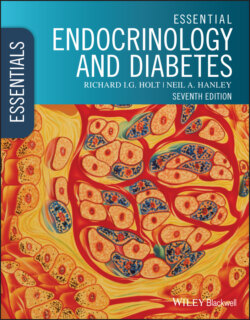Читать книгу Essential Endocrinology and Diabetes - Richard I. G. Holt - Страница 37
Synthesizing a peptide or protein hormone Gene transcription and its regulation
ОглавлениеThe stretches of DNA within genes that are pieced together as mRNA are called exons. Where there is more than one exon (and there may be very many), the intervening lengths of DNA are called introns (Figure 2.2). Introns may be very large. Upstream of the first exon is the 5‐prime (5′) flanking region of the gene, which contains the promoter. The promoter is responsible for binding transcription factors at very precise short DNA sequences (‘elements’) leading to the recruitment of RNA polymerase II, and the onset of transcription. RNA polymerase is the enzyme that ‘reads’ the DNA code. Commonly, the signal that recruits RNA polymerase to the DNA occurs at a ‘TATA’ box, a short run of adenosines and thymidines, ∼30 base pairs upstream of exon 1 (Figure 2.2) or an area rich in G and C residues. Alternatively, other types of transcription factor can bind sites in and around the promoter leading to a shut‐down of transcription (‘repression’).
Superimposed on this, gene expression often depends on more cell‐ or tissue‐specific transcription factors binding more distantly to specific stretches of DNA (‘binding motifs’) within ‘enhancers’ (short stretches of DNA which serve to upregulate gene expression) or ‘silencers’ (which suppress transcription of the gene). For instance, the transcription factor, steroidogenic factor‐1 (SF‐1) binds most preferentially to motifs comprising CCAAGGTCA nucleotides to turn on many genes specific to the adrenal cortex and gonad; when SF‐1 is absent, both organs fail to form. Enhancers may be many thousands of base pairs (kilobases) up or downstream from the gene they regulate. It is now realised that a significant part of their function, once bound by specific transcription factors, is to create three‐dimensional looping so that the enhancers and promoters come together allowing stable recruitment of RNA polymerase. Silencers are most commonly located in the immediate 5’ flanking region of the gene.
Figure 2.1 Cell division. Prior to mitosis and meiosis, the cell undergoes a period of DNA synthesis (‘S’ phase) so that the normal diploid status of DNA (2n) temporarily becomes 4n. (a) The stages of mitosis result in each daughter cell containing diploid 2n quantities of DNA. (b) Meiosis is split into two stages, each of which comprises prophase, prometaphase, metaphase, anaphase and telophase. During prophase of meiosis I, the maternally and paternally derived chromosomes align to allow crossing over (‘recombination’), a critical aspect of genetic diversity ensuring that each of the final haploid cells is genetically different from the parent cell. The two sister chromatids do not separate, so that the secondary oocyte and spermatocytes each contain 2n quantities of DNA. During the second stage of meiosis, separation of the chromatids results in haploid cells (n). In males, meiosis results in four spermatids. In females, only one ovum is produced from a primary oocyte, with smaller polar bodies extruded at both stages of meiosis.
Figure 2.2 Schematic representation of a gene, transcription and translation. In this example, the gene comprises three exons with enhancer elements in the 5′ and 3′ flanking regions and a silencer element upstream of the promoter. UTR, untranslated region; Met, methionine (encoded by the start codon).
There is another layer of complexity governing how genes are expressed. Epigenetics is the study of how gene expression is regulated by mechanisms beyond the precise DNA sequence. Methylation of DNA around genes tends to silence expression. Modification to histones, such as acetylation or methylation, alters the chromatin structure to make enhancers and promoters either accessible or inaccessible to transcription factors. Acetylation tends to open up the chromatin structure, facilitating gene expression, whereas methylation tends to close it down and silence transcription. Genomic imprinting is an epigenetic phenomenon involving DNA methylation and modifications to histones such that gene expression varies according to which parent the particular chromosome came from.
RNA contains ribose sugar moieties rather than deoxyribose. RNA polymerase attaches ribonucleotides together to generate a single strand of mRNA that correlates to the DNA code of the gene, except that in place of thymidine, a very similar nucleoside, uridine, is incorporated. The initial mRNA strand (pre‐mRNA) is processed so that intronic gene regions are removed and only the exonic sequences are ‘spliced’ together. Not all exonic regions encode protein; stretches at either end constitute the 5′ and 3′ untranslated regions (UTRs) (Figure 2.2). Within the 3′ UTR, mRNA transcription is terminated by a specific motif, the polyadenylation signal, ∼20 base pairs upstream of where the mRNA gains a stretch of adenosine residues. This polyA tail provides stability as the mRNA is moved from the nucleus to the cytoplasm for translation into protein.
